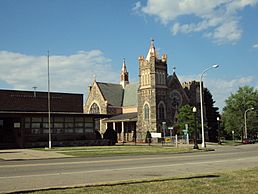Piety Hill Historic District facts for kids
|
Piety Hill Historic District
|
|

Immaculate Conception Church (814 W. Nepessing St.)
|
|
| Location | Lapeer, Michigan |
|---|---|
| Area | 15.5 acres (6.3 ha) |
| Built | 1830–1932 |
| Architectural style | Georgian, Greek Revival, Queen Anne, Second Empire, Victorian |
| MPS | Lapeer MRA |
| NRHP reference No. | 85001631 |
Quick facts for kids Significant dates |
|
| Added to NRHP | July 26, 1985 |
The Piety Hill Historic District is a special area in downtown Lapeer, Michigan. It's known for its old and important buildings. This district was officially recognized as a Michigan State Historic Site and added to the National Register of Historic Places on July 26, 1985. This means its history and buildings are protected.
Contents
What Makes Piety Hill Special?
This historic district covers about 15.5 acres (6.3 hectares). It has a unique, uneven shape. You can find its buildings along streets like Calhoun, Monroe, Madison, Washington, Main (which is also M-24), Park, Liberty, Church, and Nepessing.
Old Homes and Buildings
The district is home to 29 different properties. Many of these are old houses built between 1830 and 1850. They show off styles like Greek Revival, which looks like ancient Greek temples. You can also see homes in the Queen Anne and Second Empire styles. The newest buildings included are a library (from 1923) and a post office (from 1932). These newer buildings are in the Georgian style.
A Place of History
Piety Hill was the first planned part of Lapeer. It was also where many early religious groups gathered. Today, the district has five different church buildings. These churches were built between 1881 and 1911. Most of the other buildings in the district are single-family homes.
Famous Buildings in the District
Some buildings in Piety Hill are especially interesting. They tell stories about Lapeer's past.
The Eagle Tavern
One of the most important buildings is the Eagle Tavern. You can find it at 237 N. Main Street. In 1831, J.R. White came to Lapeer. He bought part of a lumber mill. His brother Phineas joined him the next year. The brothers soon owned the whole mill. In 1836, another brother, Enoch Jay White, decided to open a tavern. He built the Eagle Tavern in the Greek Revival style. It was located along the stagecoach route.
The Eagle Tavern is a two-story wooden building. It has a central door with a small porch. Its windows are placed evenly on both sides. The building was a tavern until 1850. Then, it became a home for two families. Around 1900, it was rented to a Catholic group. It was empty for a while starting in 1907. In 1919, E.T. White fixed up the house.
Historic Churches
The district also includes five churches. Two of the most notable are the Grace Episcopal Church and the Church of the Immaculate Conception.
Grace Episcopal Church
The Grace Episcopal Church congregation started in 1878. Work on their current church building began in 1881. This church is made of red brick. It has a Gothic Revival design. The church features a tower with a special top that looks like castle walls. It also has fourteen stained glass windows with pointed Gothic arches.
Church of the Immaculate Conception
The Church of the Immaculate Conception is a Catholic church. Its congregation first formed in 1844. Their first church building was built in 1860. In 1866, the group was officially named the Church of the Immaculate Conception. The church building you see today was started in 1896 and finished in 1901. It's made of fieldstone. It has an Early Gothic Revival design. The main entrance has three decorated, pointed arch doorways. There are two square towers at the corners.
City Buildings
Two important city buildings are also part of the district. These are the Engine House and City Hall of Lapeer, and the Lapeer Public Library.
Engine House and City Hall
The Engine House and City Hall is a large brick building. It has two stories and a rectangular shape. It was built in 1882 or 1883. It features an ornate top edge and tall second-floor windows. These windows stretch up from a stone line. The building is in the Italianate style.
Lapeer Public Library
The public library in Lapeer started in 1880. It was first located in the courthouse. In 1921, a Library Board was created. A new library building was constructed in 1923. It was designed by a famous architectural firm from Detroit. This library is a symmetrical brick building. It has Georgian Revival influences. It has a raised basement and one story on top.



